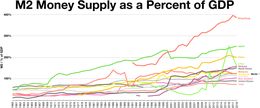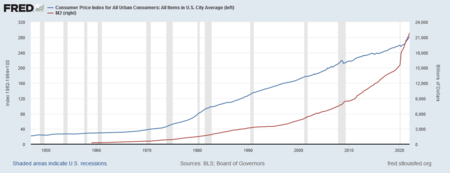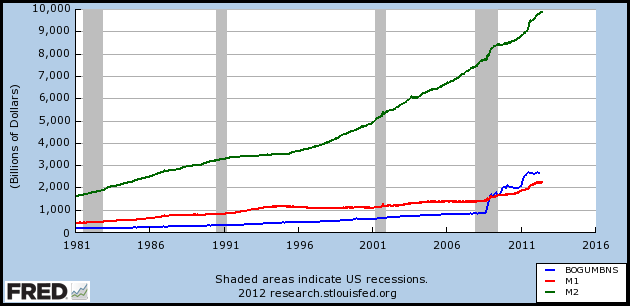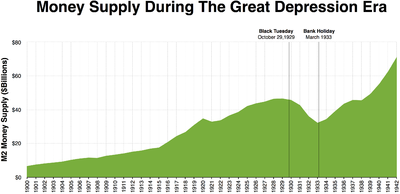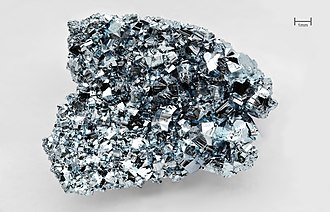China M2 money supply vs USA M2 money supply
The money supply (or money stock) is the total value of money available in an economy at a point of time. There are several ways to define "money", but standard measures usually include currency in circulation and demand deposits (depositors' easily accessed assets on the books of financial institutions). Each country’s central bank may use its own definitions of what constitutes money for its purposes.
Money supply data is recorded and published, usually by the government or the central bank
of the country. Public and private sector analysts monitor changes in
the money supply because of the belief that such changes affect the price level of securities, inflation, the exchange rates and the business cycle.
The relationship between money and prices has historically been associated with the quantity theory of money. There is strong empirical evidence of a direct relationship between the growth of the money supply and long-term price inflation, at least for rapid increases in the amount of money in the economy. For example, a country such as Zimbabwe which saw extremely rapid increases in its money supply also saw extremely rapid increases in prices (hyperinflation). This is one reason for the reliance on monetary policy as a means of controlling inflation.
The nature of this causal chain is the subject of some debate. Some heterodox economists argue that the money supply is endogenous
(determined by the workings of the economy, not by the central bank)
and that the sources of inflation must be found in the distributional
structure of the economy.
In addition, those economists
seeing the central bank's control over the money supply as feeble say
that there are two weak links between the growth of the money supply and
the inflation rate. First, in the aftermath of a recession, when many
resources are underutilized, an increase in the money supply can cause a
sustained increase in real production instead of inflation. Second, if
the velocity of money (i.e., the ratio between nominal GDP
and money supply) changes, an increase in the money supply could have
either no effect, an exaggerated effect, or an unpredictable effect on
the growth of nominal GDP.
Money creation by commercial banks
Commercial banks play a role in the process of money creation, especially under the fractional-reserve banking
system used throughout the world. In this system, money is created
whenever a bank gives out a new loan. This is because the loan, when
drawn on and spent, mostly finishes up as a deposit in the banking
system, which is counted as part of money supply. After putting aside a
part of these deposits as mandated bank reserves,
the balance is available for the making of further loans by the bank.
This process continues multiple times, and is called the multiplier effect.
This new money makes up the non-M0 components in the M1-M3 statistics. In short, there are two types of money in a fractional-reserve banking system:
- central bank money — obligations of a central bank, including currency and central bank depository accounts
- commercial bank money — obligations of commercial banks, including checking accounts and savings accounts.
In the money supply statistics, central bank money is MB while the commercial bank money is divided up into the M1-M3
components. Generally, the types of commercial bank money that tend to
be valued at lower amounts are classified in the narrow category of M1 while the types of commercial bank money that tend to exist in larger amounts are categorized in M2 and M3, with M3 having the largest.
In the United States, a bank's reserves consist of U.S. currency held by the bank (also known as "vault cash") plus the bank's balances in Federal Reserve accounts. For this purpose, cash on hand and balances in Federal Reserve ("Fed") accounts are interchangeable (both are obligations of the Fed). Reserves may come from any source, including the federal funds market, deposits by the public, and borrowing from the Fed itself.
A reserve requirement is a ratio a bank must maintain between deposit liabilities and reserves. Reserve requirements do not apply to the amount of money a bank may lend out. The ratio that applies to bank lending is its capital requirement.
Open market operations by central banks
Central banks
can influence the money supply by open market operations. They can
increase the money supply by purchasing government securities, such as government bonds or treasury bills.
This increases the liquidity in the banking system by converting the
illiquid securities of commercial banks into liquid deposits at the
central bank. This also causes the price of such securities to raise due
to the increased demand, and interest rates to fall. These funds become
available to commercial banks for lending, and by the multiplier effect from fractional-reserve banking, loans and bank deposits go up by many times the initial injection of funds into the banking system.
In contrast, when the central bank "tightens" the money supply,
it sells securities on the open market, drawing liquid funds out of the
banking system. The prices of such securities fall as supply is
increased, and interest rates raise. This also has a multiplier effect.
This kind of activity reduces or increases the supply of short
term government debt in the hands of banks and the non-bank public, also
lowering or raising interest rates. In parallel, it increases or
reduces the supply of loanable funds (money) and thereby the ability of
private banks to issue new money through issuing debt.
The simple connection between monetary policy and monetary aggregates such as M1 and M2 changed in the 1970s as the reserve requirements on deposits started to fall with the emergence of money funds, which require no reserves. At present, reserve requirements apply only to "transactions deposits" – essentially checking accounts.
The vast majority of funding sources used by private banks to create
loans are not limited by bank reserves. Most commercial and industrial
loans are financed by issuing large denomination CDs. Money market deposits are largely used to lend to corporations who issue commercial paper. Consumer loans are also made using savings deposits,
which are not subject to reserve requirements. This means that instead
of the value of loans supplied responding passively to monetary policy,
we often see it rising and falling with the demand for funds and the
willingness of banks to lend.
Some economists argue that the money multiplier is a meaningless
concept, because its relevance would require that the money supply be exogenous,
i.e. determined by the monetary authorities via open market operations.
If central banks usually target the shortest-term interest rate (as
their policy instrument) then this leads to the money supply being endogenous.
Neither commercial nor consumer loans are any longer limited by bank
reserves. Nor are they directly linked proportional to reserves. Between
1995 and 2008, the value of consumer loans has steadily increased out
of proportion to bank reserves. Then, as part of the financial crisis,
bank reserves rose dramatically as new loans shrank.
In recent years, some academic economists renowned for their work on the implications of rational expectations have argued that open market operations are irrelevant. These include Robert Lucas, Jr., Thomas Sargent, Neil Wallace, Finn E. Kydland, Edward C. Prescott and Scott Freeman. Keynesian
economists point to the ineffectiveness of open market operations in
2008 in the United States, when short-term interest rates went as low as
they could go in nominal terms, so that no more monetary stimulus could
occur. This zero bound problem has been called the liquidity trap or "pushing on a string" (the pusher being the central bank and the string being the real economy).
Empirical measures in the United States Federal Reserve System
CPI-Urban (blue) vs M2 money supply (red); recessions in gray
Money is used as a medium of exchange, a unit of account, and as a ready store of value. Its different functions are associated with different empirical
measures of the money supply. There is no single "correct" measure of
the money supply. Instead, there are several measures, classified along a
spectrum or continuum between narrow and broad monetary aggregates.
Narrow measures include only the most liquid assets, the ones most
easily used to spend (currency, checkable deposits). Broader measures
add less liquid types of assets (certificates of deposit, etc.).
This continuum corresponds to the way that different types of money are more or less controlled by monetary policy. Narrow measures include those more directly affected and controlled by monetary policy, whereas broader measures are less closely related to monetary-policy actions.
It is a matter of perennial debate as to whether narrower or broader
versions of the money supply have a more predictable link to nominal GDP.
The different types of money are typically classified as "M"s.
The "M"s usually range from M0 (narrowest) to M3 (broadest) but which
"M"s are actually focused on in policy formulation depends on the
country's central bank. The typical layout for each of the "M"s is as
follows:
| Type of money | M0 | MB | M1 | M2 | M3 | MZM |
|---|---|---|---|---|---|---|
| Notes and coins in circulation (outside Federal Reserve Banks and the vaults of depository institutions) (currency) | ✓ | ✓ | ✓ | ✓ | ✓ | ✓ |
| Notes and coins in bank vaults (vault cash) |
|
✓ |
|
|
|
|
| Federal Reserve Bank credit (required reserves and excess reserves not physically present in banks) |
|
✓ |
|
|
|
|
| Traveler's checks of non-bank issuers |
|
|
✓ | ✓ | ✓ | ✓ |
| Demand deposits |
|
|
✓ | ✓ | ✓ | ✓ |
| Other checkable deposits (OCDs), which consist primarily of negotiable order of withdrawal (NOW) accounts at depository institutions and credit union share draft accounts. |
|
|
✓ | ✓ | ✓ | ✓ |
| Savings deposits |
|
|
|
✓ | ✓ | ✓ |
| Time deposits less than $100,000 and money-market deposit accounts for individuals |
|
|
|
✓ | ✓ |
|
| Large time deposits, institutional money market funds, short-term repurchase and other larger liquid assets |
|
|
|
|
✓ |
|
| All money market funds |
|
|
|
|
|
✓ |
- M0: In some countries, such as the United Kingdom, M0 includes bank reserves, so M0 is referred to as the monetary base, or narrow money.
- MB: is referred to as the monetary base or total currency. This is the base from which other forms of money (like checking deposits, listed below) are created and is traditionally the most liquid measure of the money supply.
- M1: Bank reserves are not included in M1.
- M2: Represents M1 and "close substitutes" for M1. M2 is a broader classification of money than M1. M2 is a key economic indicator used to forecast inflation.
- M3: M2 plus large and long-term deposits. Since 2006, M3 is no longer published by the US central bank. However, there are still estimates produced by various private institutions.
- MZM: Money with zero maturity. It measures the supply of financial assets redeemable at par on demand. Velocity of MZM is historically a relatively accurate predictor of inflation.
The ratio of a pair of these measures, most often M2 / M0, is called an (actual, empirical) money multiplier.
Definitions of "money"
United States
Money supply decreased by several percent between Black Tuesday and the Bank Holiday in March 1933 when there were massive bank runs across the United States.
The United States Federal Reserve published data on three monetary aggregates until 2006, when it ceased publication of M3 data and only published data on M1 and M2. M1 consists of money commonly used for payment, basically currency in circulation and checking account
balances; and M2 includes M1 plus balances that generally are similar
to transaction accounts and that, for the most part, can be converted
fairly readily to M1 with little or no loss of principal. The M2 measure
is thought to be held primarily by households. Prior to its
discontinuation, M3 comprised M2 plus certain accounts that are held by
entities other than individuals and are issued by banks and thrift
institutions to augment M2-type balances in meeting credit demands, as
well as balances in money market mutual funds held by institutional
investors. The aggregates have had different roles in monetary policy as
their reliability as guides has changed. The principal components are:
- M0: The total of all physical currency including coinage. M0 = Federal Reserve Notes + US Notes + Coins. It is not relevant whether the currency is held inside or outside of the private banking system as reserves.
- MB: The total of all physical currency plus Federal Reserve Deposits (special deposits that only banks can have at the Fed). MB = Coins + US Notes + Federal Reserve Notes + Federal Reserve Deposits
- M1: The total amount of M0 (cash/coin) outside of the private banking system plus the amount of demand deposits, travelers checks and other checkable deposits
- M2: M1 + most savings accounts, money market accounts, retail money market mutual funds, and small denomination time deposits (certificates of deposit of under $100,000).
- MZM: 'Money Zero Maturity' is one of the most popular aggregates in use by the Fed because its velocity has historically been the most accurate predictor of inflation. It is M2 – time deposits + money market funds
- M3: M2 + all other CDs (large time deposits, institutional money market mutual fund balances), deposits of eurodollars and repurchase agreements.
- M4-: M3 + Commercial Paper
- M4: M4- + T-Bills (or M3 + Commercial Paper + T-Bills)
- L: The broadest measure of liquidity, that the Federal Reserve no longer tracks. L is very close to M4 + Bankers' Acceptance
- Money Multiplier: M1 / MB. As of December 3, 2015 it was 0.756. While a multiplier under one is historically an oddity, this is a reflection of the popularity of M2 over M1 and the massive amount of MB the government has created since 2008.
Although the Treasury can and does hold cash and a special deposit
account at the Fed (fed funds), these assets do not count in any of the
aggregates. So in essence, money paid in taxes paid to the Federal
Government (Treasury) is excluded from the money supply. To counter
this, the government created the Treasury Tax and Loan
(TT&L) program in which any receipts above a certain threshold are
redeposited in private banks. The idea is that tax receipts won't
decrease the amount of reserves in the banking system. The TT&L
accounts, while demand deposits, do not count toward M1 or any other
aggregate either.
When the Federal Reserve announced in 2005 that they would cease
publishing M3 statistics in March 2006, they explained that M3 did not
convey any additional information about economic activity compared to
M2, and thus, "has not played a role in the monetary policy process for
many years." Therefore, the costs to collect M3 data outweighed the
benefits the data provided. Some politicians have spoken out against the Federal Reserve's
decision to cease publishing M3 statistics and have urged the U.S.
Congress to take steps requiring the Federal Reserve to do so.
Congressman Ron Paul
(R-TX) claimed that "M3 is the best description of how quickly the Fed
is creating new money and credit. Common sense tells us that a
government central bank creating new money out of thin air depreciates
the value of each dollar in circulation." Modern Monetary Theory disagrees. It holds that money creation in a free-floating fiat currency
regime such as the U.S. will not lead to significant inflation unless
the economy is approaching full employment and full capacity. Some of
the data used to calculate M3 are still collected and published on a
regular basis. Current alternate sources of M3 data are available from the private sector.
As of April 2013, the monetary base was $3 trillion and M2, the broadest measure of money supply, was $10.5 trillion.
United Kingdom
M4 money supply of the United Kingdom 1984–2007. In thousand millions (billions) of pounds sterling.
There are just two official UK measures. M0 is referred to as the "wide monetary base" or "narrow money" and M4 is referred to as "broad money" or simply "the money supply".
- M0: Cash outside Bank of England + banks' operational deposits with Bank of England. (When the Bank introduced Money Market Reform in May 2006, the Bank ceased publication of M0 and instead began publishing series for Reserve Balances at the Bank of England to accompany Notes and Coin in circulation.)
- M4: Cash outside banks (i.e. in circulation with the public and non-bank firms) + private-sector retail bank and building society deposits + private-sector wholesale bank and building society deposits and certificates of deposit. In 2010 the total money supply (M4) measure in the UK was £2.2 trillion while the actual notes and coins in circulation totalled only £47 billion, 2.1% of the actual money supply.
There are several different definitions of money supply to reflect the
differing stores of money. Owing to the nature of bank deposits,
especially time-restricted savings account deposits, M4 represents the
most illiquid measure of money. M0, by contrast, is the most liquid measure of the money supply.
Eurozone
The Euro money supply from 1998–2007.
The European Central Bank's definition of euro area monetary aggregates:
- M1: Currency in circulation + overnight deposits
- M2: M1 + deposits with an agreed maturity up to 2 years + deposits redeemable at a period of notice up to 3 months.
- M3: M2 + repurchase agreements + money market fund (MMF) shares/units + debt securities up to 2 years
Australia
The money supply of Australia 1984–2016
The Reserve Bank of Australia defines the monetary aggregates as:
- M1: currency in circulation plus bank current deposits from the private non-bank sector
- M3: M1 + all other bank deposits from the private non-bank sector, plus bank certificate of deposits, less inter-bank deposits
- Broad money: M3 + borrowings from the private sector by NBFIs, less the latter's holdings of currency and bank deposits
- Money base: holdings of notes and coins by the private sector plus deposits of banks with the Reserve Bank of Australia (RBA) and other RBA liabilities to the private non-bank sector.
New Zealand
New Zealand money supply 1988–2008
The Reserve Bank of New Zealand defines the monetary aggregates as:
- M1: notes and coins held by the public plus chequeable deposits, minus inter-institutional chequeable deposits, and minus central government deposits
- M2: M1 + all non-M1 call funding (call funding includes overnight money and funding on terms that can of right be broken without break penalties) minus inter-institutional non-M1 call funding
- M3: the broadest monetary aggregate. It represents all New Zealand dollar funding of M3 institutions and any Reserve Bank repos with non-M3 institutions. M3 consists of notes & coin held by the public plus NZ dollar funding minus inter-M3 institutional claims and minus central government deposits
India
The Reserve Bank of India defines the monetary aggregates as:
- Reserve Money (M0): Currency in circulation + Bankers' deposits with the RBI + 'Other' deposits with the RBI = Net RBI credit to the Government + RBI credit to the commercial sector + RBI's claims on banks + RBI's net foreign assets + Government's currency liabilities to the public – RBI's net non-monetary liabilities. M0 outstanding was ₹14.75 trillion in August 2017.
- M1: Currency with the public + Deposit money of the public (Demand deposits with the banking system + 'Other' deposits with the RBI). M1 was 184 per cent of M0 in August 2017.
- M2: M1 + Savings deposits with Post office savings banks. M2 was 879 per cent of M0 in August 2017.
- M3: (Broad concept of money supply)M1+ Time deposits with the banking system = Net bank credit to the Government + Bank credit to the commercial sector + Net foreign exchange assets of the banking sector + Government's currency liabilities to the public – Net non-monetary liabilities of the banking sector (Other than Time Deposits). M3 was 880 per cent of M0 in August 2017.
- M4: M3 + All deposits with post office savings banks (excluding National Savings Certificates).
Hong Kong
HKD vs USD over the year
In 1967, when sterling was devalued, the dollar's peg to the pound
was increased from 1 shilling 3 pence to 1 shilling 4½ pence (14.5455
dollars = 1 pound) although this did not entirely offset the
devaluation. In 1972 the Hong Kong dollar
was pegged to the U.S. dollar at a rate of 5.65 H.K. dollar = 1 U.S.
dollar. This was revised to 5.085 H.K. dollar = 1 U.S. dollar in 1973.
Between 1974 and 1983 the Hong Kong dollar floated. On 17 October 1983
the currency was pegged at a rate of 7.8 H.K. dollar = 1 U.S. dollar,
through the currency board system.
As of 18 May 2005, in addition to the lower guaranteed limit, a new upper guaranteed limit was set for the Hong Kong dollar
at 7.75 to the American dollar. The lower limit was lowered from 7.80
to 7.85 (by 100 pips per week from 23 May to 20 June 2005). The Hong Kong Monetary Authority
indicated that this move was to narrow the gap between the interest
rates in Hong Kong and those of the United States. A further aim of
allowing the Hong Kong dollar to trade in a range is to avoid the HK
dollar being used as a proxy for speculative bets on a renminbi revaluation.
The Hong Kong Basic Law and the Sino-British Joint Declaration
provides that Hong Kong retains full autonomy with respect to currency
issuance. Currency in Hong Kong is issued by the government and three
local banks under the supervision of the territory's de facto central bank, the Hong Kong Monetary Authority. Bank notes are printed by Hong Kong Note Printing.
A bank can issue a Hong Kong dollar only if it has the equivalent
exchange in US dollars on deposit. The currency board system ensures
that Hong Kong's entire monetary base is backed with US dollars at the
linked exchange rate. The resources for the backing are kept in Hong
Kong's exchange fund, which is among the largest official reserves in
the world. Hong Kong also has huge deposits of US dollars, with official
foreign currency reserves of 331.3 billion USD as of September 2014.
Japan
Japanese money supply (April 1998 – April 2008)
The Bank of Japan defines the monetary aggregates as:
- M1: cash currency in circulation + deposit money
- M2 + CDs: M1 + quasi-money + CDs
- M3 + CDs: (M2 + CDs) + deposits of post offices + other savings and deposits with financial institutions + money trusts
- Broadly defined liquidity: (M3 + CDs) + money market + pecuniary trusts other than money trusts + investment trusts + bank debentures + commercial paper issued by financial institutions + repurchase agreements and securities lending with cash collateral + government bonds + foreign bonds
Link with inflation
Monetary exchange equation
The money supply is important because it is linked to inflation by the equation of exchange in an equation proposed by Irving Fisher in 1911:
where
- is the total dollars in the nation's money supply,
- is the number of times per year each dollar is spent (velocity of money),
- is the average price of all the goods and services sold during the year,
- is the quantity of assets, goods and services sold during the year.
In mathematical terms, this equation is an identity
which is true by definition rather than describing economic behavior.
That is, velocity is defined by the values of the other three variables.
Unlike the other terms, the velocity of money has no independent
measure and can only be estimated by dividing PQ by M. Some adherents
of the quantity theory of money assume that the velocity of money is
stable and predictable, being determined mostly by financial
institutions. If that assumption is valid then changes in M can be used
to predict changes in PQ. If not, then a model of V is required in order
for the equation of exchange to be useful as a macroeconomics model or
as a predictor of prices.
Most macroeconomists replace the equation of exchange with equations for the demand for money
which describe more regular and predictable economic behavior.
However, predictability (or the lack thereof) of the velocity of money
is equivalent to predictability (or the lack thereof) of the demand for
money (since in equilibrium real money demand is simply Q/V). Either way, this unpredictability made policy-makers at the Federal Reserve rely less on the money supply in steering the U.S.economy. Instead, the policy focus has shifted to interest rates such as the fed funds rate.
In practice, macroeconomists almost always use real GDP to define
Q, omitting the role of all transactions except for those involving
newly produced goods and services (i.e., consumption goods, investment
goods, government-purchased goods, and exports). But the original
quantity theory of money did not follow this practice: PQ was the
monetary value of all new transactions, whether of real goods and
services or of paper assets.
U.S. M3 money supply as a proportion of gross domestic product.
The monetary value of assets, goods, and services sold during the year could be grossly estimated using nominal GDP
back in the 1960s. This is not the case anymore because of the dramatic
rise of the number of financial transactions relative to that of real
transactions up until 2008. That is, the total value of transactions
(including purchases of paper assets) rose relative to nominal GDP
(which excludes those purchases).
Ignoring the effects of monetary growth on real purchases and
velocity, this suggests that the growth of the money supply may cause
different kinds of inflation at different times. For example, rises in
the U.S. money supplies between the 1970s and the present encouraged
first a rise in the inflation rate for newly produced goods and services
("inflation" as usually defined) in the ‘70’s and then asset-price inflation
in later decades: it may have encouraged a stock market boom in the
'80s and '90s and then, after 2001, a rise in home prices, i.e., the
famous housing bubble.
This story, of course, assumes that the amounts of money were the
causes of these different types of inflation rather than being
endogenous results of the economy's dynamics.
When home prices went down, the Federal Reserve
kept its loose monetary policy and lowered interest rates; the attempt
to slow price declines in one asset class, e.g. real estate, may well
have caused prices in other asset classes to rise, e.g. commodities.
Rates of growth
In terms of percentage changes (to a close approximation, under low growth rates),
the percentage change in a product, say XY, is equal to the sum of the
percentage changes %ΔX + %ΔY). So, denoting all percentage changes as
per unit of time,
- %ΔP + %ΔQ = %ΔM + %ΔV.
This equation rearranged gives the basic inflation identity:
- %ΔP = %ΔM + %ΔV – %ΔQ.
Inflation (%ΔP) is equal to the rate of money growth (%ΔM), plus the
change in velocity (%ΔV), minus the rate of output growth (%ΔQ). So if in the long run the growth rate of velocity and the growth rate of real GDP are exogenous
constants (the former being dictated by changes in payment institutions
and the latter dictated by the growth in the economy’s productive
capacity), then the monetary growth rate and the inflation rate differ
from each other by a fixed constant.
As before, this equation is only useful if %ΔV follows regular
behavior. It also loses usefulness if the central bank lacks control
over %ΔM.
Arguments
Historically, in Europe, the main function of the central bank is to maintain low inflation. In the USA the focus is on both inflation and unemployment. These goals are sometimes in conflict (according to Phillips curve).
A central bank may attempt to do this by artificially influencing the
demand for goods by increasing or decreasing the nation's money supply
(relative to trend), which lowers or raises interest rates, which
stimulates or restrains spending on goods and services.
An important debate among economists in the second half of the
twentieth century concerned the central bank's ability to predict how
much money should be in circulation, given current employment rates and
inflation rates. Economists such as Milton Friedman believed that the central bank would always get it wrong, leading to wider swings in the economy than if it were just left alone.
This is why they advocated a non-interventionist approach—one of
targeting a pre-specified path for the money supply independent of
current economic conditions—even though in practice this might involve
regular intervention with open market operations (or other monetary-policy tools) to keep the money supply on target.
The former Chairman of the U.S. Federal Reserve, Ben Bernanke,
suggested in 2004 that over the preceding 10 to 15 years, many modern
central banks became relatively adept at manipulation of the money
supply, leading to a smoother business cycle, with recessions tending to
be smaller and less frequent than in earlier decades, a phenomenon
termed "The Great Moderation" This theory encountered criticism during the global financial crisis of 2008–2009.
Furthermore, it may be that the functions of the central bank may need
to encompass more than the shifting up or down of interest rates or bank
reserves: these tools, although valuable, may not in fact moderate the volatility of money supply (or its velocity).


